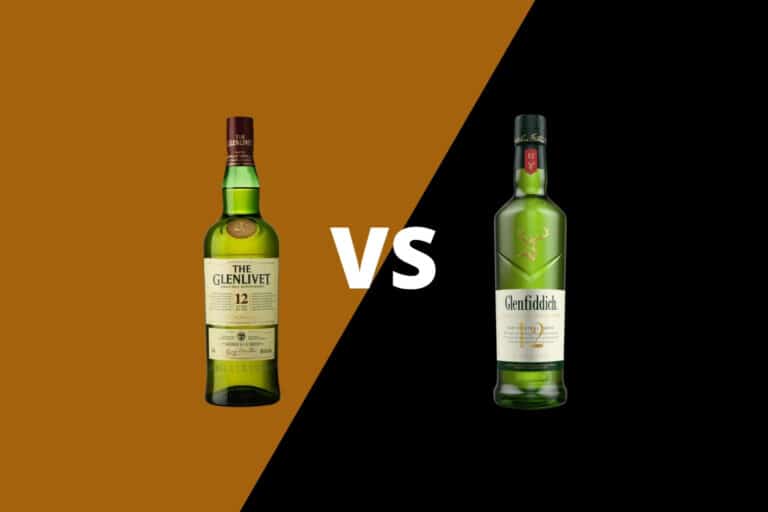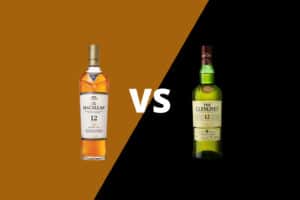Battle of the glens.
This matchup is between two of the most recognizable names in single malt whisky. Any whiskey lover who admits to never trying either of these scotch whiskies will have a hard time being taken seriously in a crowd of aficionados.
If you’re looking for insight into what makes these two brands stand out, why these bottles may have a higher price point than other products in the broader scotch or whiskey aisle, and what all the fuss about single malt is about — you’ve come to the right place. Read on in our Glenlivet vs Glenfiddich comparison post to learn more about these line-priced competitors so that you can order confidently the next time you’re in the liquor aisle of your favorite bottle shop or your butt is parked in a stool at your favorite dram house.
Table of Contents
History
Scotland has a long and illustrious history of illicit distillation.
Each of these brands represents a physical place. Glenfiddich translates to Valley of the Deer, and Glenlivet is a parish near Ballindalloch in Moray, Scotland. In the 18th and early 19th century, spirits distillation was intentionally made difficult and expensive — in part to combat the infamous ‘gin craze’ in London, in which alcoholism plagued common folk and threatened to pull the nation into poverty. As a result, Scots living in the rural areas away from city centers like Edinburgh and Glasgow distilled illicit whisky — what might be considered moonshine in the United States.
Glenlivet’s beginnings reflect that period. Throughout the United Kingdom, people recognized the superior flavor of distillates from that area. Before changes to excise law in 1823, there were an unknown number of illicit distilleries in the area making whisky that was colloquially called by the Glenlivet name. When the law changed to make legal distillation in Scotland more feasible, George Smith became the first to receive a license.
His neighbors weren’t thrilled.
You might have noticed ‘the’ before Glenlivet, while Glenfiddich and other scotch brands do not use the article in front of its name. Over the years, Smith defended the distillery against threats to both his business and his person. Legal claims to trademark eventually landed on ‘The Glenlivet,’ reflected in today’s packaging, branding, and licensing.
Glenfiddich was founded in 1886 by William Grant in the glen of the River Fiddich.
For decades single malt scotch brands like Glenfiddich and the Glenlivet were well regarded in the United Kingdom but seldom enjoyed outside of the British Commonwealth. Single malt has a flavor profile vastly different from bourbon, and many Americans didn’t get it. Some of the first Americans outside of the privileged elite who could afford to travel to London to try single malt scotch included servicemen during the two world wars. During the Battle of Britain, for example, naval officers and airmen were able to appreciate the product at officers’ clubs and brought a taste for it back to the states.
The perseverance of both companies through the Great Depression and Prohibition put them in a prime position to benefit during the post-war whiskey boom during the 1950s. Both brands were some of the first single malts to be actively promoted outside of Scotland. Today, single malt brands like The Glenlivet and Glenfiddich are household names.
Mashbills
It’s crazy that all the diverse single malt category flavors result from one single grain — malted barley. According to UK law, single malt scotch must contain a mash bill of 100 percent malted barley.
Although single malt fermentation shares a lot in common with other types of whiskey, it has its own nuance based on hundreds of years of tradition and is reflected in the terminology.
First, the malted grains are ground and combined with water to produce a mash. Here, scotch producers diverge with American distillers by lautering the brew to remove solids. The result is called wort.
The wort is transferred to washbacks for fermentation. Many distilleries use traditional wooden washbacks. Glenfiddich, for example, utilizes traditional hand-built washbacks made of Douglas fir. Using wood for fermentation vessels allows colonies of microorganisms to flourish. Organisms like lactobacillus — a bacteria that generates favorable flavors — produce unique compounds that are not present in ferments produced in stainless steel fermentation tanks. These may not be temperature controlled. Glenfiddich’s website mentions ‘hints of pear’ that may result from compounds like propanol and ethyl caprylate that form as yeast are stressed by high temperatures.
Natural springs were the main reason the region flourished during early distillation. Glenfiddich uses water ‘Robbie Dhu’ spring water in mashing and dilution. The Glenlivet pulls water from Josie’s Well and other springs surrounding the distillery.
Before climate-controlled facilities, the cool spring water would help to cool ferments and condensers. And the minerality of the spring water creates a perfect environment for the yeast and promotes fermentation.
The Speyside Region
Here, we’ll introduce the idea of Scotland’s whisky-producing regions. Five geographical regions in Scotland help describe the various styles of single malt scotch available. Although there are no other production requirements other than the distillery produce single malt and be located within the boundaries of the region, the distilleries within each region mirror traditions that go back centuries. The single malts produced in each region reflect influences including the area’s history, local agriculture, trends in consumption and changes to UK law.
In 2009, these regions were updated to the five regions we are familiar with today, and each bottle of single malt sold must reflect one of these regions on the label.
The scotch production regions are: the Highlands, the Lowlands, Speyside, Islay, Campbeltown and Islay. The Glenlivet and Glenfiddich are located in the Speyside region — named after and revolving around the River Spey, or Speyburn.
Before the 2009 update, Speyside was considered part of the Highlands. With over 40 active distilleries, the Speyside region offers the most brands and Speyside whiskies are known to be complex and often offer a smooth taste due to the influence of the water. A limestone shelf sits beneath the Speyburn, which provides a clean, cool, mineral-rich water source of spring water that has proven helpful to distillers throughout all production phases — from mashing to distillation, maturation and bottling.
Flavor profiles run the gamut from light and floral to heavy and oily. Both The Glenlivet and Glenfiddich are recognized as being on the light and smooth side of the spectrum. Each utilizes nearby springs to produce its whiskies.
Distillation & Production
According to UK law, single malt scotch whiskies must be produced in a single distillery using traditional copper pot stills from a mashbill of 100 percent malted barley.
The single malt distiller operates two stills — first, a wash still, then a spirit still for the second distillation. After the first distillation, low-proof low wines are collected and fed into the spirit still. After the second distillation, the clear unaged new make spirit comes off the still at up to 94.8 percent ABV, or 189.6-proof.
Distillation is conducted on traditional copper pot stills, unlike many other types of whiskey that utilize modern column stills.
Glenfiddich keeps a coppersmith on-site to this day to tend to the historic copper pot stills — which really are a work of art to behold. There are 28 unique stills at the facility, which offer a depth of flavor when constructing the final product.
In marketing materials, Glenfiddich claims the cut point for the final distillation is precisely gauged to the hydrometer and has been the same since the distillery’s first spirit run in 1887.
This may be baffling to modern distillers who have worked in the American craft scene — where small batches of bourbon, rye and malt whiskey can vary wildly from mash to mash based on batches of grain, suppliers, fermentation tanks, ambient and water temperatures, stills used and other factors. Often, cut points vary wildly to reflect the distiller’s sensory perceptions and personal preference, as well as the hydrometer and temperature gauges used to make the hearts and tails cuts. That the distillers can rely solely on one metric — the hydrometer — is a testament to how finely tuned the machinery at Glenfiddich has become after over 130 years of making almost exclusively one product.
Maturation
Both brands rely heavily on American oak casks purchased from bourbon and Tennessee whisky producers on the secondary market. In addition to American oak, Spanish Oloroso sherry and other casks are used for maturation. Some single malt distilleries, including Glenfiddich, employ an on-site cooper, who may choose to toast or char barrels before refilling. This allows old barrels to offer more diverse flavor compounds during maturation.
Before being placed into oak to mature, new make is diluted using spring water. Casks are filled at about 63.5 percent ABV or 127-proof.
After casks have matured, whiskies are disgorged and married. Distilleries often utilize large wooden marrying vats to mingle the barrels before bottling. Again, the spring water is added for dilution before bottling.
According to UK law, products must be matured for three years in wooden containers to be considered scotch whisky. In this post, we compare the 12-year-old expressions of each brand — considered their core range of products. The 12 year age statement is a legal guarantee that no cask used in this particular product batch was under 12 years old – and many may have been matured in the whisky warehouse for much longer.
But we should consider that each brand has a wide selection of individual products in their respective portfolios.
Ownership, Price & Value
The Glenfiddich is owned by UK-based spirits producer William Grant & Sons. A 750mL bottle will cost about $55 and is bottled at 80-proof.
The Glenlivet is produced by French-based spirits producer Pernod Ricard. A 750mL bottle will cost about $52 and is bottled at 80-proof.
Tasting Notes
The Glenlivet 12-Year-Old Single Malt Scotch Whisky
Description: In the glass, the Glenlivet 12 has a medium hue, with the color of burnished copper. Pronounced legs, especially at 80-proof.
Nose: Honey and heather, fruity notes of raising and dried figs, sandalwood, vanilla, coconut with a slight citrus note.
Palate: Oaky vanilla and cinnamon, honey, toffee, raisins, caramel and a hint of smokiness
Finish: Floral clover notes and coconut, cinnamon and pepper with lingering honey notes.
Glenfiddich 12-Year-Old Single Malt Scotch Whisky
Description: In the glass, the Glenfiddich has a medium yellow hue with a russet color. It has moderate legs at 80-proof.
Nose: Sandalwood and cigar box, cut grass, pepper, bran cereal.
Palate: Oily mouthfeel, oak, herbal notes, apples and pears, nutty almond, cinnamon, tobacco, vanilla.
Finish: Oak, campfire, cinnamon, tobacco, nuttiness.
Verdict…
This is an easy win-win for Glenlivet vs Glenfiddich. If you want to get into scotch, if you want to learn more about single malt, try these two brands.
Either of these is perfect for that friend who says, ‘I don’t like scotch.’ Give them a glass of either Glenfiddich or the Glenlivet, and if they don’t reconsider, they’ve got deeper issues.
















